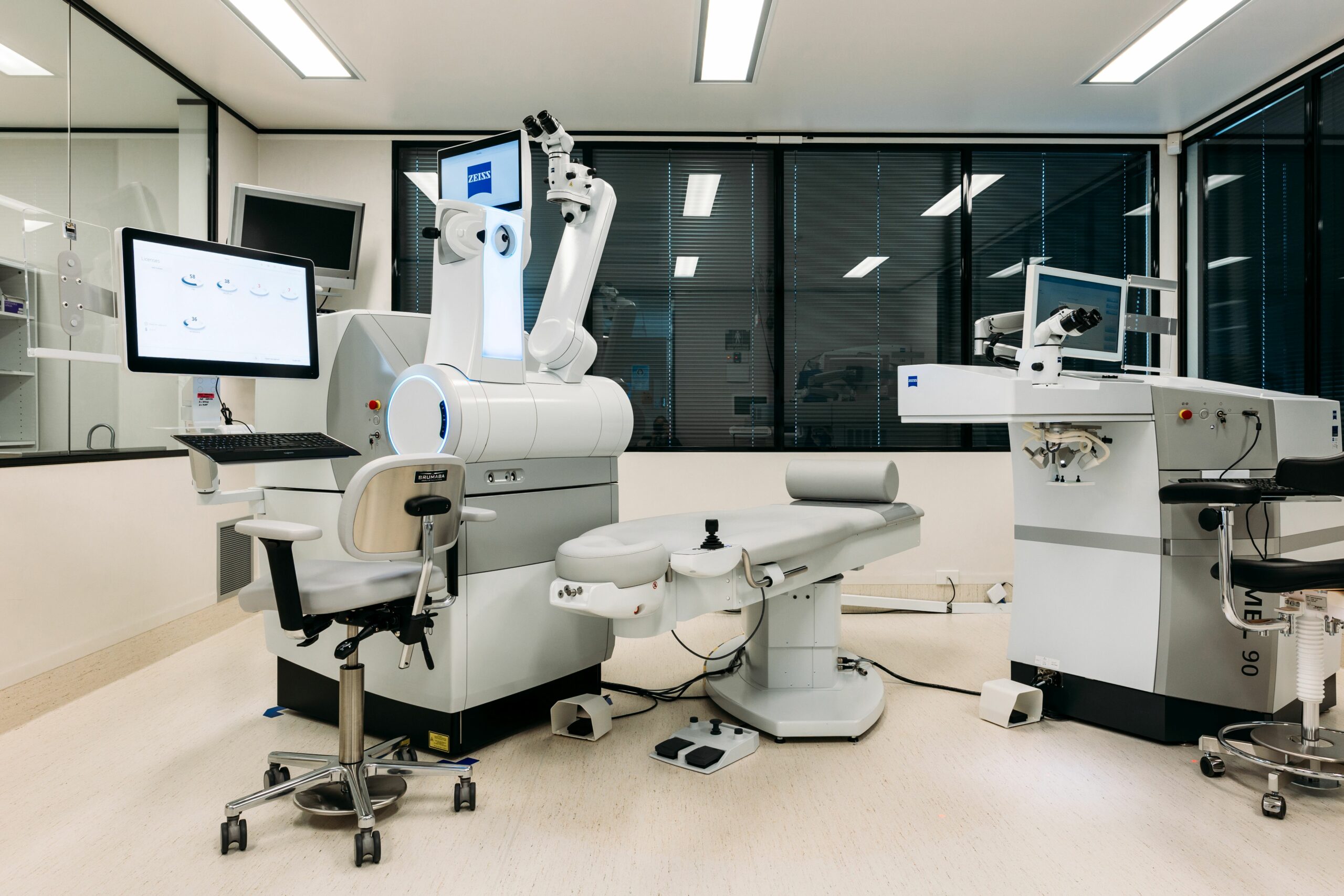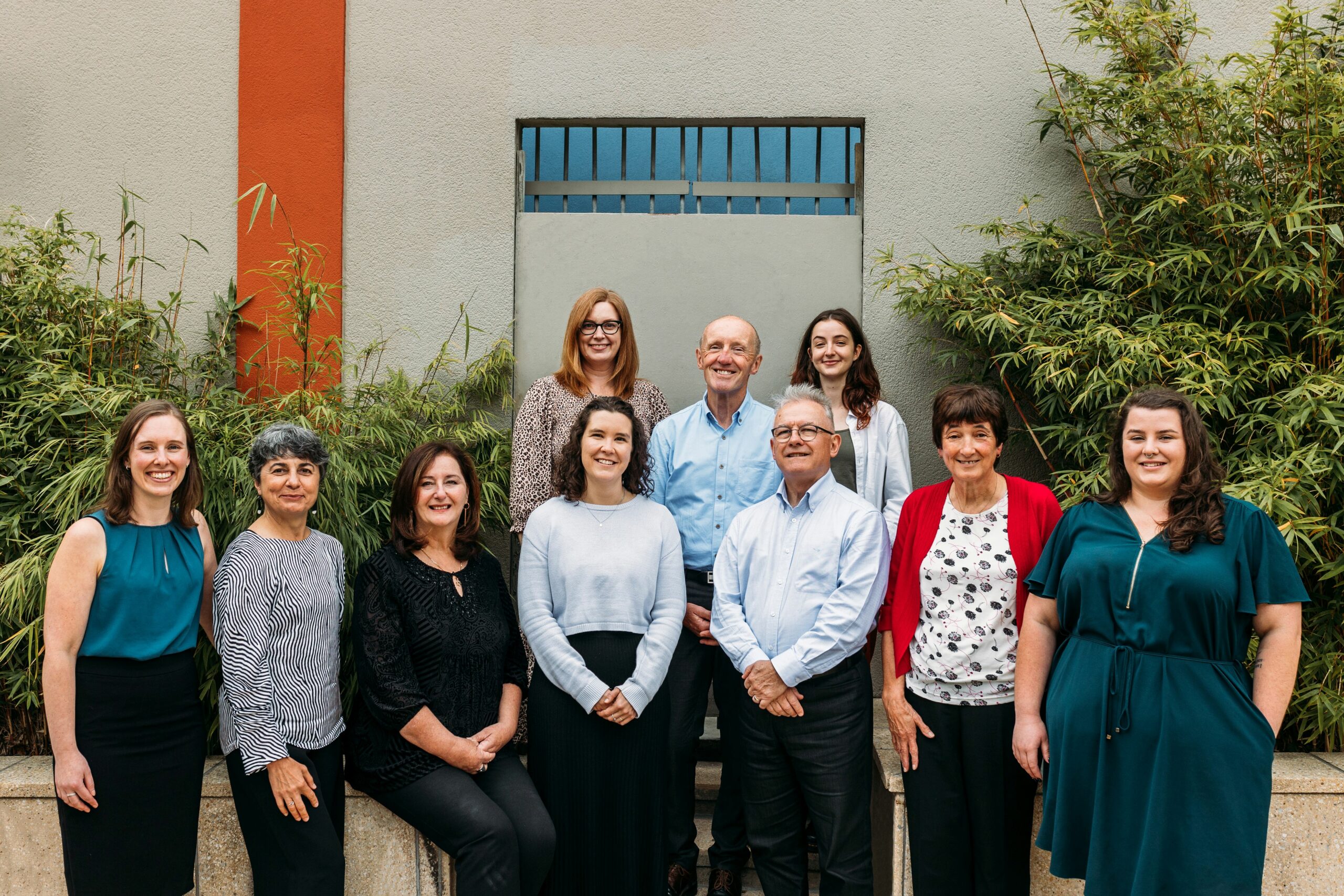Wellington Eye Centre’s Ophthalmologist
Since the first laser eye surgery was performed in 1987, millions of people across the globe have undergone the impressive procedure. With constantly evolving technology and increasingly sophisticated techniques, the surgery is more popular now than ever. Despite the growing interest, one of the most common misconceptions about laser eye surgery is the level of risk involved. We’ve previously debunked other laser eye surgery myths such as “laser eye surgery is painful” or “it can only correct short sightedness”. In this article, Dr. Andrew Logan explores the potential risks and complications of the operation.
How does laser eye surgery work?
All laser eye surgery procedures (LASIK, SMILEⓇ or PRK) work in the same manner. That is by reshaping- the clear part of the eye in front of the iris, also known as the cornea. This changes the eye’s focal point, focusing it neatly onto the back of the eye and giving a clear image.
Short sightedness is when the focal point sits inside the eye, away from the back where it needs to be and is caused by the eye being too long or the cornea too curved. Whereas long sightedness is caused by the eye being too short or the cornea too flat, resulting in the focal point being behind the eye. Short sighted vision is corrected by flattening the cornea to reduce the refractive power and pushing the focal point back onto the retina at the back of the eye, whilst for long sighted vision the cornea is steepened, increasing the refractive power and moving the focal point back inside the eyeball.
Before you get to surgery, there is a process that needs to be followed. At the Wellington Eye Centre this involves having a comprehensive medical exam to check the health and wellbeing of the eyes and the physical qualities of the cornea. This is carried out by one of our technicians, our Optometrist and our surgeon, Dr Andrew Logan. This appointment is to help us ensure that it would be safe for you to receive laser eye surgery.
On the day of surgery
You are with us for around one and a half hours. First, you will have a pre-operative talk to go over your post-surgery instructions, medications, what to expect, etc. You will then go with our nurse to have local anaesthetic drops applied to the surface of the eye. These ensure that the surface of the eye is numb and you will still be able to control the movement of your eye. You are then taken into our theatre and the relevant surgery is performed.
Afterwards, you are checked by Dr Logan before going home to rest. The healing time for each surgery is slightly different and this will be discussed with you in your medical examination and pre-operative talk. You will be provided with paracetamol to ease any discomfort following surgery which is normally most pronounced for the first 8-12 hours after. During this time, it can feel like you have something in your eye as well as a slight burning sensation for a few hours which will quickly pass. We also provide you with a busy regime of eye drops which are to be used roughly every couple of hours while you are awake. Following your immediate recovery, you will have regular follow up care (day one after surgery, one week, one month, three months, six months and one year) to ensure your recovery is going well.
Is laser eye surgery safe?
Studies carried out in the United States have shown that the most common reason that people who wear glasses or contact lenses do not have laser eye surgery performed is not the cost, but fear of the procedure itself. The safest way to correct your vision is to wear glasses. Glasses can easily be updated, provide eye protection from physical injuries and reduce UV light exposure.
Contact lenses are another alternative to correct vision. However, although contacts do not use surgery to correct vision, they may not be as safe long-term. A study in 2006 found that the risk of significant vision loss following LASIK was 0.001% but contact lens wearers had a 1% risk of developing a serious contact lens associated corneal infection and 0.02% risk of significant vision loss over 30 years of contact lens wear⁽¹⁾. Since that time, both contact lens technology and laser eye surgery technology have improved enormously but the relative risks remain similar.
To put things into perspective, in the United States the most common occupational group to have laser eye surgery performed is ophthalmologists. I, Dr Andrew Logan, had LASIK surgery performed on my eyes over 23 years ago using the much less sophisticated technology available then, and I would have the procedure performed again today without any hesitation.

What are the risks of laser eye surgery?
The vast majority of people who have had laser eye surgery have had excellent outcomes and no significant complications. However, laser eye surgery is like any other surgical procedure in the sense that it is not “risk-free”. If you are considering having laser eye surgery performed, it is important to be aware of the risks involved in the surgery and to be comfortable with the low but not non-existent level of risk.
Postoperative corneal infection
Infection, whilst the most serious complication which could occur following laser eye surgery, is very uncommon. If infection occurs, it can potentially cause severe corneal scarring which could require a corneal transplant to restore vision. However, the largest study on infection following LASIK surgery reported from Spain in 2010 and included over 200,000 individual eyes treated with LASIK⁽²⁾. Infection occurred in only 82 eyes across 63 patients, a risk of just over three per 10,000 procedures or 0.03%. Of these patients, 93% of the affected eyes maintained good vision after successful treatment of the infection. No patients required a corneal transplant.
I, Andrew Logan, have seen just one patient who developed corneal infections in both eyes following LASIK surgery. Their procedure was carried out at a laser clinic outside Wellington and the patient was treated successfully at Wellington hospital and retained perfect vision after the infection had resolved.
The risk of corneal infection following SMILE laser eye surgery is still uncertain because so few cases have been reported. Well over 2 million SMILE procedures had been performed across the globe by mid-2019. But I have only been able to find five corneal infections reported in medical literature following this type of surgery. Two patients were reported with bacterial infections affecting both eyes, and one patient developed a fungal infection in one eye. It is likely that the risk of infection following SMILE is up to 10 times less than after LASIK surgery. This is due to the quick healing time of SMILE compared to LASIK, as it is a keyhole surgery.
Dry Eyes
Dry eyes are very common in the first few months after having laser eye surgery. This is because there is a temporary decrease in tear production, due to reduced corneal sensation which occurs as a result of the surgery. This is usually more of an issue after LASIK than after SMILE or PRK. For the first six months or so after your surgery, your eyes may feel unusually dry as they heal, but in almost all cases the problem will resolve after 6 to 12 months.
Some people are more prone to getting dry eyes after laser eye surgery. This includes people with pre-existing dry eyes prior to having laser eye surgery, people with inflamed eyelid margins (blepharitis), post-menopausal women, and people with autoimmune diseases such as Sjogren’s syndrome, lupus and rheumatoid arthritis.
Managing dry eyes usually involves the regular use of artificial tears. Taking an Omega 3 oil supplement, such as Krill oil, can be very helpful. Some people may need to have temporary plugs placed in their tear ducts to slow drainage of tears from the surface of the eyes. Finally, treatment of any blepharitis (eyelid inflammation) may be started if more simple treatment measures are not sufficient. Dry eyes can reduce the quality of your vision so it is important to manage it following surgery.

Glare and halos
Many people who have had laser eye surgery experience glare and halos at night in the first few weeks after their surgery, but these days it is very uncommon for this to be a longer-term problem. Glare and halos is when street lights and headlights at night appear brighter and larger than usual or appear to have a ring around the light source.
Persistent problems with night vision were more common in the early years of laser eye surgery in the 1990s. They were also more likely to occur with large corrections and the small laser treatment zones that were used at that time. In recent years, our much better understanding of why these problems occurred has resulted in improved laser treatment patterns which have meant that night vision problems are much less common, even with larger corrections.
Undercorrection and overcorrection
Laser eye surgery, whether it is LASIK, SMILE or PRK, is not completely predictable. Every eye is slightly different, and some eyes over or under respond to a given amount of laser treatment. This means that you can end up slightly short sighted or long sighted, even though the correct measurements were fed into the laser. This happens more frequently with bigger corrections and long sighted patients.
A review of studies between 2008 and 2015, covering the clinical outcomes of LASIK was published. This included 97 relevant articles and represented 67,893 eyes⁽³⁾. It was found that 98.6% of eyes were within ±1.0 dioptre of the target refraction. SMILE surgery has been shown to be slightly more predictable than LASIK.
In most cases, if an undercorrection or overcorrection has occurred, a retreatment can safely be performed to get the required vision correction. Retreatments are not normally performed earlier than 6 to 12 months after the initial surgery.
Astigmatism
Astigmatism is the term used to describe a regular distortion of the cornea so that it has a slight “rugby ball” shape (slightly more curved on one axis, slightly less curved on the other), unlike a cornea which has no astigmatism and is “soccer ball” shaped (equally curved on all axes). In rare cases astigmatism can develop after laser surgery.
This is a similar outcome to being under or overcorrected, an irregular astigmatism may also result in double vision. Residual astigmatism may require a retreatment surgery, glasses or contact lenses.
Flap problems
FemtoLASIK surgery involves cutting a thin flap of corneal tissue using a femtosecond laser. This flap is then lifted out of the way and an excimer laser is used to reshape the tissue under the flap to correct vision. The flap is then repositioned in its original location. The corneal flap heals very slowly and can be displaced in the first few weeks after surgery. It’s most likely to happen if the eye is rubbed.
If the flap shifts, the eye will usually become very uncomfortable and vision will become markedly worse. When this occurs the flap can usually be repositioned with full recovery of vision as long as this is done promptly. If a displaced or wrinkled flap is not treated promptly, it can become very difficult to get it back into the correct position.
It is important to avoid rubbing the eye or exposing it to trauma after having LASIK surgery, especially in the first few months after surgery. Flap wrinkling and displacement was more common when LASIK flaps were cut using a mechanical cutter called a microkeratome but has become much less common with the use of lasers to make the corneal flaps.
Occasionally, skin cells from the surface of the eye can grow underneath the flap – a condition called epithelial ingrowth. This is relatively uncommon after a first LASIK procedure but occurs more commonly after retreatments. In many cases, the skin cells that have grown under the flap can be left alone without causing issues. However, if the area of skin under the flap is large or increasing in size or is affecting vision or the health of the surface of the eye, the LASIK flap may need to be lifted to allow removal of the ingrown skin cells.
Vision loss or changes
Rarely, you may experience a loss in quality of vision due to surgical complications. Some people also may not see as sharply or clearly as they did with glasses or contacts prior to having laser eye surgery. This can occur if the reshaping of the cornea to correct vision, or the healing of the corneal surface, has resulted in a complication. If this occurs, it may be possible to improve vision with further laser surgery, or it may be necessary to wear glasses or contacts to achieve satisfactory vision.
Ectasia
Ectasia is the term used to describe a rare but serious complication which can occur after having laser eye surgery. This is a condition in which the cornea develops progressive bulging and distortion, and results in deterioration in vision.
Laser eye surgery involves removing small amounts of corneal tissue to reshape the cornea, and this causes slight weakening of the cornea. Most corneas have enough strength to not be adversely affected by this small reduction in strength, but some corneas have an underlying weakness which predisposes them to develop ectasia. In most, but not all cases, these “weaker” corneas can be detected by testing carried out during the laser assessment and laser eye surgery can be avoided.
If ectasia does develop after laser eye surgery, a procedure called corneal collagen cross linking will usually be carried out. Cross linking strengthens the cornea and will stop further distortion of the cornea. Vision may still be poor and it may be necessary to wear glasses or contacts to get good vision.

How can you avoid complications from laser eye surgery?
To reduce the risk of complications we recommend:
- Having a comprehensive examination with an experienced laser eye surgeon to ensure your eyes are suited to surgery. This should include looking at the thickness and shape of your cornea as well as your overall eye health. Our surgeon Dr Andrew Logan has been performing laser eye surgery for over 20 years.
- Follow all post procedure instructions – this will include actions to reduce the chance of infection, flap displacement and dry eyes.
- Drops! Make sure you use all eye drops as directed.
At the Wellington Eye Centre, we understand that the list of complications can be quite daunting. However, the vast majority of people having laser eye surgery obtain excellent postoperative vision without significant complications. The overall safety and effectiveness of laser eye surgery has improved enormously in the over thirty years that these procedures have been performed. And our team takes every possible precaution, always going the extra mile to ensure that you are well informed and your eyes are in safe hands.
Feel free to get in touch with the team at Wellington Eye Centre if you have any other questions or wish to book a consultation with Dr Logan. You can call us on 0800 733 327 or complete the contact form below.
SMILE® is a registered trademark of Carl Zeiss Meditec.
References
1. Risk of LASIK surgery vs contact lenses. Mathers, W.D, Fraunfelder, F.W and Rich, L.F. Archives of Ophthalmology, 2006, Vol. 124(10), pp. 1510-1511.
2. Infectious keratitis in 266,191 laser in situ keratomileusis. Llovet-Osuna, F., et al. Archives of the Spanish Society of Ophthalmology, 2010, Vol. 85(11), pp. 355-359.
3. Modern laser in situ keratomileusis outcomes. Sandoval, HP., et al. Journal of Cataract & Refractive Surgery, 2016, Vol. 42(8), pp. 1224-1234.

What to Expect on The Day of Surgery

What happens when your vision after laser vision correction surgery is not what you expected?

Am I too old to have laser eye surgery?

Dr Andrew Logans Innovation Achievements

Laser Eye Surgery for Sports

Meet The Team at the Wellington Eye Centre

Festive Season and Your Eyes

Naumi Studio Hotel Wellington

What to Expect on The Day of Surgery

